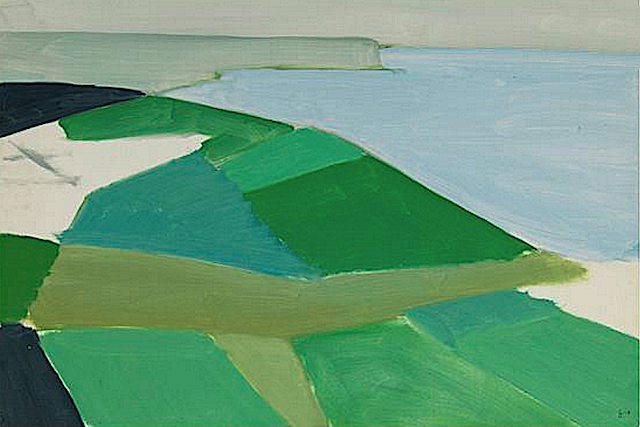Le Mourre Nègre (1,125m)
France (Provence)
In Landscape-Ménerbes 1953-54, Huile sur toile, Musée Fabre Montpellier
A propos de cette composition
Titrée " Landscape-Ménerbes" cette composition est une évocation des paysages du Luberon visibles autour et à partir de Ménerbes, où Nicolas de Staël posséda une maison. On a donc supposé
qu'il s'agissait d'une évocation des divers reliefs du Luberon visibles alentour dont le trait noir du Mourre Nègre, dans le lointain, barrerait le centre du tableau. Staël comme beaucoup d'autres peintres et pas seulement modernes, ne désigna jamais les montagnes qu'il peignit.
La montagne
Le Mourre Nègre (1,125m) est le point culminant du massif du Luberon. Ce sommet arrondi est aujourd'hui coiffé d'une antenne hertzienne, ce qui le signale d'assez loin.Mourre et nègre viennent tous deux du provençal, le premier signifie « museau » et est souvent utilisé pour désigner des sommets de forme arrondie. Nègre désigne la couleur « noire ». Il est situé dans le Grand Luberon, partie principale du massif tant en taille qu'en longueur et largeur.à cheval sur les communes d'Auribeau, de Cabrières-d'Aigues et de Castellet-en-Luberon. A partir de Ménerbes, il ne peut être visible que dans le lointain, ce qui semble être le cas dans ce tableau. Ouverts ou semi-ouverts (restriction en période de sècheresse) à la circulation routière, le « chemin des crêtes » et le « chemin des cavaliers » parcourent les sommets du Grand Luberon dont le Mourre Nègre. On y accède par Lourmarin, Cucuron, Cabrières-d'Aigues et Vitrolles-en-Luberon côté Sud Luberon ainsi que par Auribeau côté Nord Luberon joignant par la même occasion à la frontière départementale la route départementale de Vaucluse 33 qui devient 31 dans les Alpes-de-Haute-Provence. Plusieurs autres chemins permettent la découverte du Luberon. Certains sont réservés aux marcheurscomme les chemins de grande randonnée GR 4, 6, 9, 92 et 97 , d'autres aux VTTistes ou cavaliers.
Le peintre
Nicolas de Staël (prononcé [stal) baron Nikolaï
Vladimirovitch Staël von Holstein (Николай Владимирович Шталь фон
Гольштейн), est un peintre français originaire de Russie, issu d'une
branche cadette de la famille Staël von Holstein. La carrière de Nicolas
de Staël s'étale sur quinze ans, de 1940 à sa mort. Artiste prolifique,
il réalise au cours de sa carrière 1120 tableaux aux influences
diverses — Cézanne, Matisse, Van Gogh, Braque, Soutine et les fauves,
mais aussi les maîtres néerlandais Rembrandt, Vermeer et Seghers. Sa
peinture est en constante évolution. Des couleurs sombres de ses débuts (Porte sans porte, 1946 ou Ressentiment, 1947), elle aboutit à l'exaltation de la couleur comme dans le Grand Nu orange (1953).
Ses toiles se caractérisent par d'épaisses couches de peinture
superposées et un important jeu de matières, passant des empâtements au
couteau (Compositions, 1945-1949) à une peinture plus fluide (Agrigente, 1954, Chemin de fer au bord de la mer, soleil couchant,
1955). Refusant les étiquettes et les courants, tout comme Georges
Braque qu'il admire, il travaille avec acharnement, détruisant autant
d’œuvres qu'il en réalise. Nicolas de Staël meurt à 41 ans en se jetant
de la terrasse de la maison où il avait son atelier à Antibes. Cette
maison fut classée monument historique en mars 2014. Il est enterré au
cimetière de Montrouge. Par son style évolutif, qu'il a lui-même
qualifié d'« évolution continue », il reste une énigme pour les
historiens d'art qui le classent aussi bien dans la catégorie de l'École
de Paris, que dans les abstraits ayant inspiré les jeunes peintres à
partir des années 1970, ou encore dans la catégorie de l'art informel.
Il a maintes fois créé la surprise notamment avec la série Les Footballeurs, entraînant
derrière lui des artistes d'un nouveau mouvement d'abstraction et les
artistes du néo-formalisme new-yorkais, ou de l'expressionnisme abstrait
de l'École de New York, parmi lesquels se trouve notamment Joan
Mitchell.
______________________________________
2023 - Gravir les montagnes en peinture
Un blog de Francis Rousseau



,%201954%20oil%20on%20canvas%2088.3%20x%20129.5%20cm%20Private%20collection.jpg)




